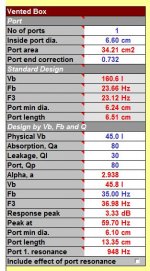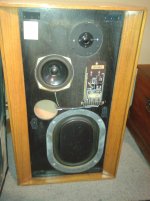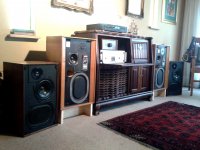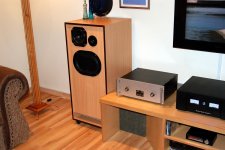Are you able to explain how you arrived at the figures above?
I used a simulation program. Attached the result of UniBox for comparison. It calculates a minimum port diameter of 61 mm and a vent length of 133.5 mm for a tuning frequency of 35 Hz. Not much difference. 🙂
A wider port does not help at all, the vent gets much longer!
Attachments
Thanks for that Dissi, I will download a copy of UniBox and try to make sense of it.
Incidentally, I imagine that I should be basing my calculations on the B200 SP1022 rather than the BD139? I have downloaded this spec sheet from which I get the following details, most of which I can't claim to understand.
Incidentally, I imagine that I should be basing my calculations on the B200 SP1022 rather than the BD139? I have downloaded this spec sheet from which I get the following details, most of which I can't claim to understand.
Reflex enclosure volume = 40 to 50 litres
Nominal freq. range = 25 Hz to 3,500 Hz
Magnet flux density = 1.25T (12,500 gauss)
Sensitivity = 96 dB SPL at 1 metre from 8.5 V
Voice coil diameter = 26 mm
Voice coil inductance = 0.32 mH
Nominal DC resistance Rdc = 7.1 Ω
Minimum impedance = 6.9 Ω at 220 Hz
Effective area Sd = 232 sq. cms.
Effective moving mass Md= 24.0 gms
Max. linear excursion Xd = 6 mm (peak to peak)
Max. damage limited excursion = 12 mm (peak to peak)
Nominal free air resonance fs = 25 Hz
Total mechanical resistance of suspension Rms = 0.43 mech Ω
Suspension compliance Cms = 1.78 x 10 (to the power of -3) m/N
Equivalent volume of compliance Vas = 134.5 litres
Mechanical damping Qm = 8.5
Electrical damping Qe = 0.43
Total damping Qt = 0.41
I have also located some 65 mm drain pipe in the garage so I can start experimenting with that.Nominal freq. range = 25 Hz to 3,500 Hz
Magnet flux density = 1.25T (12,500 gauss)
Sensitivity = 96 dB SPL at 1 metre from 8.5 V
Voice coil diameter = 26 mm
Voice coil inductance = 0.32 mH
Nominal DC resistance Rdc = 7.1 Ω
Minimum impedance = 6.9 Ω at 220 Hz
Effective area Sd = 232 sq. cms.
Effective moving mass Md= 24.0 gms
Max. linear excursion Xd = 6 mm (peak to peak)
Max. damage limited excursion = 12 mm (peak to peak)
Nominal free air resonance fs = 25 Hz
Total mechanical resistance of suspension Rms = 0.43 mech Ω
Suspension compliance Cms = 1.78 x 10 (to the power of -3) m/N
Equivalent volume of compliance Vas = 134.5 litres
Mechanical damping Qm = 8.5
Electrical damping Qe = 0.43
Total damping Qt = 0.41
WinISD is a very helpful program.
First select File >New Project, them select your driver from the database. There is a KEF B200G half way down the list.
Click 1 driver and normal then next. Select vented box then finish.
Enlarge the window so that you can move the driver data way from covering the graph. This graph is the low frequency response for an ideal size cabinet and reflex port the program chooses and your starting point.
On the speaker diagram click on box then in the upper selection insert your cabinet size, for example 35 liter.
You can fool around with the tuning frequency and see the result on the graph. When satisfied with the result, click on vents and insert the number of vents and the pipe diameter you want to use use and whether they are round or rectangular. The the result block will display the vent length.
It took me longer to write this post than to design the speaker.
First select File >New Project, them select your driver from the database. There is a KEF B200G half way down the list.
Click 1 driver and normal then next. Select vented box then finish.
Enlarge the window so that you can move the driver data way from covering the graph. This graph is the low frequency response for an ideal size cabinet and reflex port the program chooses and your starting point.
On the speaker diagram click on box then in the upper selection insert your cabinet size, for example 35 liter.
You can fool around with the tuning frequency and see the result on the graph. When satisfied with the result, click on vents and insert the number of vents and the pipe diameter you want to use use and whether they are round or rectangular. The the result block will display the vent length.
It took me longer to write this post than to design the speaker.
This program does work. I have both KEF Cadenza and Concerto as well as transmission-lines using B139s.
There is a limit to the SPL of the vent and how much it assists your driver in a particular box volume and driver.
A Vent and ABR does not perform the same because the ABR resonating frequency is due to its mass and compliance and much lower than you would get with the air and a vent.
Therefore you cannot really expect the Cadenza with a vent to sound like anything like one with and ABR. If they were the same one would wonder why designers go for the expense of an ABR if they could just drill a hole in the box.
There is a limit to the SPL of the vent and how much it assists your driver in a particular box volume and driver.
A Vent and ABR does not perform the same because the ABR resonating frequency is due to its mass and compliance and much lower than you would get with the air and a vent.
Therefore you cannot really expect the Cadenza with a vent to sound like anything like one with and ABR. If they were the same one would wonder why designers go for the expense of an ABR if they could just drill a hole in the box.
When you develop speakers play at moderate levels, then all the modifying parts can be made simply for cut cardboard. Once you are happy with the physical sound you can replace the cardboard with timber and plastics in your final design.
The second speaker looks suspiciously like a Cadenza, complete with functioning ABR! Is the third one something from IMF?I have these speakers and used KEF for almost 50 years
The cardboard idea for prototyping sounds like a good one although I will probably experiment with hardboard because that is what I happen to have lying about - thanks.
HaHa, we got it about right first time with 60mm diameter and 12Cm long reflex. You get used to the way these things look for typical speakers. I just used the Visaton info since I'm a bit rough and ready myself:
W 200 S - 8 Ohm
But really, Dissi's adjustable tube looks just the job:
66mm Standard Bass Reflex Port Tube
You won't go far wrong with that. Thing is, if it doesn't work, you fiddle with it till it does in best diy tradition. Or is that too simple? 😀
W 200 S - 8 Ohm
But really, Dissi's adjustable tube looks just the job:
66mm Standard Bass Reflex Port Tube
You won't go far wrong with that. Thing is, if it doesn't work, you fiddle with it till it does in best diy tradition. Or is that too simple? 😀
I notice that the Kef Chorale also uses a T27 and a B200 (SP1014 rather than SP1022) but no Passive Auxiliary Bass Radiator (PABR) in a significantly smaller box of half the weight (so presumably less rigid?) with a different crossover (SP1015 vs SP1019) and suffers only 5Hz worse bass.
I have made and placed panels over the holes left by the removed PABRs and had a listen. There is a definite "boom" at some point so I will drill holes and install 12 cms ports made of plastic drain pipe and brace these panels this weekend and try again.
All good clean low-cost fun!
I have made and placed panels over the holes left by the removed PABRs and had a listen. There is a definite "boom" at some point so I will drill holes and install 12 cms ports made of plastic drain pipe and brace these panels this weekend and try again.
All good clean low-cost fun!
- Status
- Not open for further replies.
- Home
- Loudspeakers
- Multi-Way
- Ex Kef Cadenza Kef T27 & B200



